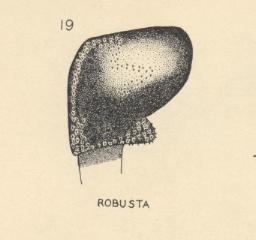
William D. Murray, 1940 · 1
Podalonia robusta, male penis valve |
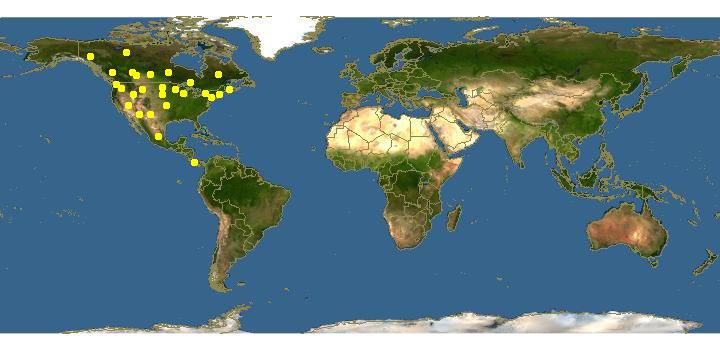
Click on map for details about points.
|
80x5 -
240x3 -
240x4 -
320x1 -
320x2 -
320x3 -
640x1 -
640x2
Set display option above.
Click on
images to enlarge. |
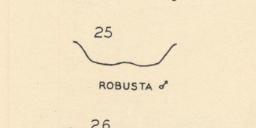
William D. Murray, 1940 · 1
Podalonia robusta, clypeus |
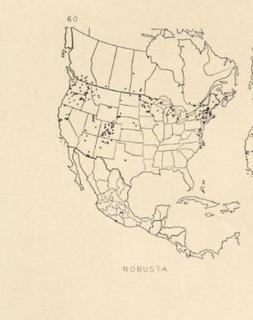
William D. Murray, 1940 · 1
Podalonia robusta, map |
|
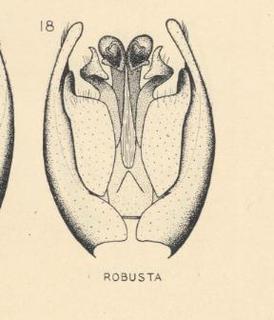
William D. Murray, 1940 · 1
Podalonia robusta, male genitalia |
|
Overview |
Taken from the text:
Podalonia (Hymenoptera: Sphecidae) of North and Central America. William Donald Murray. Entomologica Americana, 1940.
Podalonia robusta (Cresson)
(Figures 18, 19, 25, 60)
1865. Ammophila robusta Cresson. Proc. Phila. Ent. Soc. 4: 461-462. Female (in part).
1865. Ammophila. communis Cresson, Proc. Phila. Ent. Soc. 4: 462. Male (in part).
1882. Ammophila communis Provancher, Natural. Canad 13: 13. Male, female (in part).
1883. Ammophila communis Provancher, Faun. Entom. Canad. Hym. 2: 614. Male, female (in part).
?1902. Psammophila communis Melander & Brues, Biol. Bul. 3: 40-42. Male, female (in part).
?1903. Ammophila grossa Melander, Psyche 10: 156-164. Male, female (in part).
1903. Ammophila violaceipennis Melander, Psyche .10: 156-164. Male, female (in part).
1908. Psammophila grossa H. S. Smith, Univ. Nebr. Studies 8: 330-331. Female (in part).
1908. Psammophila violaceipennis H. S. Smith, Univ. Nebr. Studies 8: 330-331. Male (in part).
1917. Psammophila grossa Mickel, Univ. Nebr. Studies 17: 87- 88. Female (in part.).
1917. Psammophila violaceipennis Mickel, Univ. Nebr. Studies 17: 87-88. Male (in part).
1917. Psammophila. violaceipennis Rohwer, Proc. U. S. Nat. Mus. 53: 241. Female.
1917. Psammophila violaceipennis Rohwer, Conn. Geol. & Nat. Hist. Surv. 22: 681. Male, female (in part).
?1925. Psammophila grossa Carter, Canad. Thu. 57: 132. Male, female.
1927. Podalonia violaceipennis Fernald, Proc. U. S. Nat. Mus. 71, Art. 9, pp. 30-37.
?1936. Podalonia violaceipennis Krombein, Ent. News 47: 93- 99. Female.
1936. Podalonia violaceipennis Balduf, Canad. Ent. 68: 137- 138. Female (in part).
Male.--(See figures 18 and 19 for genitalia.) Length 15 mm. Head: clypeal margin extending downwards and somewhat inwards for a distance, then bending and extending almost transversely but slightly downwards for an equal distance, then curving smoothly to run slightly upwards to center, forming a slight central emargination; frontal suture distinct to anterior ocellus; a rather long shallow frontal depression, its surface granulate; surface of frons with large rounded punctures and many tiny punctures, the latter especially noticeable along frontal suture and extending onto depression; pilosity of head moderately heavy, black. Thorax: collar broadly rounded; mesopleuron with very large round punctures, tiny punctures sparse on upper part but increasing in numbers below; surface of mesopleuron with very fine reticulation which cuts down gloss; propodeal side and metapleuron with broken ridges and large punctures, surface reticulate and with very fine ridges; metanotal flange moderate in size; some pilose hairs of thorax all black, especially anteriorly, some all white, especially laterally, and some black basally and with white tips. Petiole: slender. Abdomen: first segment piceous, reddish laterally, second segment entirely red, third red at base ventrally, rest of abdomen dark blue.
Female.--Length 16 mm. Head: clypeus rather bulging, peak of bulge below middle of clypeus dorso-ventrally; elypeus with many large punctures and a reticulate surface throughout; upper edge of clypeus slightly curved; frontal depression not as evident as in male. Thorax: propodeal side and metapleuron more strongly ridged than in male; mesopleuron more conspicuously reticulate than in male; mesopleuron with almost no tiny punctures; pilosity of thorax entirely black. Petiole: slender, distinctly longer than hind coxa, proportion being 1.25 for petiole to 1 for coxa. Abdomen: first, second, and anterior half of third segments entirely red, rest of abdomen dark blue.
Redescribed from a male and a female, both having been compared with the holotype; male, Viking, Minnesota, Aug. 10, 1935 (D. G. Denning) ; female, Todd Co., Minnesota, Aug. 14, 1936 (D. Murray) ; both are located in the collection of the University of Minnesota, St. Paul, Minn.
Holotype.--Female, Colorado; located in the collection of the American Entomological Society, Philadelphia, Pa.
Allotype.--The male described herein is designated as the allo-type.
Specimens examined: 296 male, 310 female; total specimens 606.
Robusta has been collected in the following states, provinces and countries: MAINE, NEW HAMPSHIRE (June 10-Sept. 18), VERMONT, MASSACHUSETTS, CONNECTICUT, NEW JERSEY, PENNSYLVANIA, MICHIGAN, WISCONSIN, ILLINOIS, MINNESOTA (June 10-Sept. 19), NORTH DAKOTA, SOUTH DAKOTA, NEBRASKA, KANSAS, TEXAS, MONTANA, WYOMING, COLORADO (May 18-Oct. 1), NEW MEXICO, UTAH, ARIZONA, IDAHO, WASHINGTON (May 25-Sept. 26), OREGON, CALIFORNIA, NOVA SCOTIA, NEW BRUNSWICK, QUEBEC, ONTARIO, MANITOBA, SASKATCHEWAN, ALBERTA, BRITISH COLUMBIA, MEXICO, COSTA RICA.
Variations.--Male : length 12-16 mm. ; frontal suture occasionally obsolete in upper part of frontal depression; frontal depression sometimes scarcely evident; collar sometimes only moderately rounded ; mesopleuron sometimes with many tiny punctures over entire plate, and short ridges in front of the large punctures; white sericeous hairs sometimes arise from most of the tiny punctures of mesopleuron, these hairs not as long or as abundant as in sericea; rarely surface of anterior part of metapleuron glossy; rarely propodeal side and metapleuron with large round punctures and no ridges whatever ; ridges of metapleuron and propodeal side sometimes strong and run across both segments; sometimes metanotal flange quite small; rarely dark part of abdomen black rather than dark blue; in western specimens dark part of abdomen usually more brilliantly blue than in eastern specimens; in one specimen abdomen entirely blue except for second segment, this being entirely red ventrally and with a narrow red band dorsally; pilosity of thorax varying from all white except on prothorax and mesonotum, where some hairs have black bases, to all black. Female: length 13-19 mm.; large punctures of frons occasionally irregular in size and shape, resembling those in sericea; occasionally ridges of metapleuron and propodeal side run strongly forwards; first four abdominal segments occasionally entirely red; pilosity of petiole, propodeum, meta- and mesopleura sometimes partly white, though the black hairs become more numerous anteriorly.
For distinctions between robusta and its most closely related species, see the notes following the descriptions of sericea, violaceipennis, mickeli, occidentalis and parallela.
|
|
|
Names | |
|
|
| Supported by | |
Updated: 2024-04-23 22:12:12 gmt
|